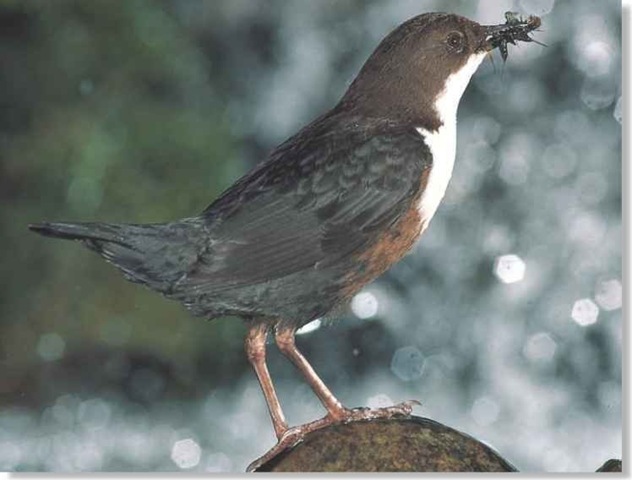ORDER
Passeriform.es
FAMILY
Cinclidae
GENUS & SPECIES
KEY FEATURES
• Perches on rocks in mountain torrents while constantly bobbing (or dipping) up and down, waiting to launch into the water to catch prey
• Skilled at wading in shallows, plunging into whitewater or walking along stony streambeds
• Builds its nest a few feet from running water
WHERE IN THE WORLD?
On and beside rapidly flowing streams in upland Europe and mountainous regions of northwest Africa, the Middle East, Russia and central Asia
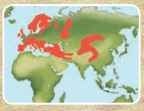
Lifecycle
Amid the splash and swirl of rushing rivers and bubbling streams, the dipper swims, flies, feeds and nests, displaying a complete mastery of this challenging environment.
HABITAT
The dipper — with the other four members of its family — is adapted to a specific habitat: it’s restricted to clear, fast-flowing streams in mountainous and hilly areas and never moves far from its watery home. It inhabits shallow streams with gravelly bottoms and rocky banks that lack vegetation, often choosing a prime spot where the torrent rushes down a ravine or plunges into a deep chasm. In hard winters, even mountain streams can partially freeze. Then, the dipper may move to lower altitudes, to lakesides and rocky coastlines.
Stepping stones The dipper rests on rocks midstream and often sings a territorial warning.
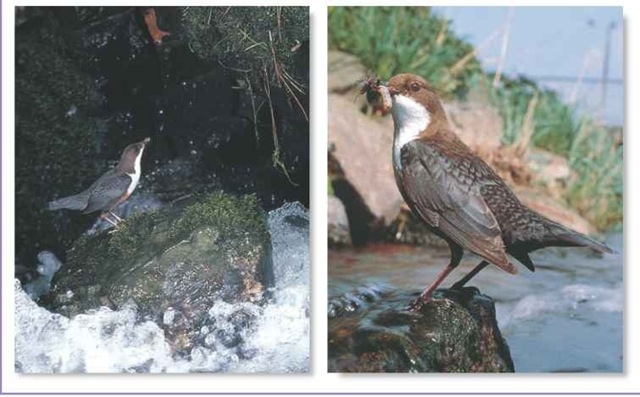
BREEDING
In early spring, the dipper selects a nest site along its home stretch of stream. The nest is normally wedged into a crevice in a vertical slab of rock under a bridge or behind a waterfall. Both male and female build the moss nest, spending three weeks on the task.
Parents feed chicks in a “carousel.” Each chick moves to the back of the nest once it’s been fed, to allow its siblings a chance. When they leave the nest, at 22 days old, the young seek refuge in streamside vegetation. Mastering the water takes several weeks.
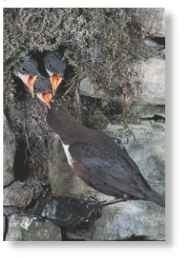
A Dome of the rock The nest, shaped like a basketball, clings to rock-faces above water
CONSERVATION
Scientific studies show that the dipper’s populations are stable through most of its European range — with the exception of eastern Germany and Poland, where chemical pollution of rivers and streams may be the cause of its decline. But recent political changes in Eastern Europe have given a higher priority to conservation, and it’s likely that pollution levels will be slowly reduced there.
BEHAVIOR
It’s not known why the dipper”dips.” By repeatedly bobbing up and down it appears restless and hyperactive, as if it can’t keep still. One explanation is that the dipper is constantly adjusting its field of vision to spot prey, another is that it’s signaling to other birds or keeping contact with its mate.
Territorial all yea^the male dipper defends his section of stream against all other males. Rivals face each other on adjacent rocks, while singing loudly and bobbing frantically.
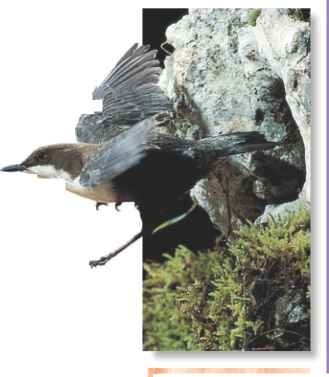
Warning in white The male flashes his white “bib” in territorial displays.
Given the push Intruding males are usually forced to flee the scene.
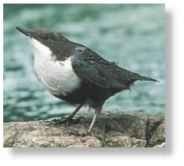
FOOD & FEEDING
The dipper uses a range of feeding methods. It carefully picks insects off rocks on the surface, chases tiny fish and crustaceans underwater by swimming with powerful wingbeats or locates snails, worms and insect larvae by walking on the streambed.
A variety of insects and their larvae make up the dipper’s diet, but the larvae of caddis flies are its main prey. These larvae live in tubes they construct from grains of sand and fragments of plant material and hide under streambed stones. The dipper snatches a “tube” in its bill before squeezing out the larva or breaking the tube against a rock.
MAKING A SPLASH
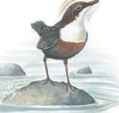
1 Dip, dip, dip…
On a rock in the middle of a stream, a dipper rapidly bobs up and down while flicking its tail. Checking that all is clear…

2 Going down…
…the dipper plunges into the water. It dives, propelling itself by beating its wings. Despite the strong current, it’s an agile swimmer.
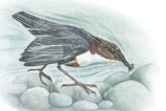
3 Rock-bottom…
The dipper can walk along the streambed as if on land. As it moves, it turns over stones to reveal insect larvae and other prey.
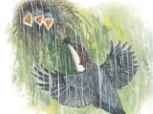
4 Home and dry
Popping to the surface like a cork, the dipper swims to a rock. If it has young, it returns to the nest, which is often hidden behind a waterfall.
# One dipper nest site was used for 123 years by successive generations.
# The male dipper isn’t always faithful to his mate. Males have been seen visiting neighboring nests to feed the young, which they probably fathered.
The dipper’s preen gland is ten times larger than any other bird’s in the order Passeriformes, which includes 60% of the world’s bird species. This reflects the length and frequency of its preening sessions, when it repairs and waterproofs the damage caused to its feathers by rough water.
Profile
Differ
To cope with the ravages of rough water and spray, the dipper has waterproof feathers, while its eyes and nostrils are protected by special membranes.
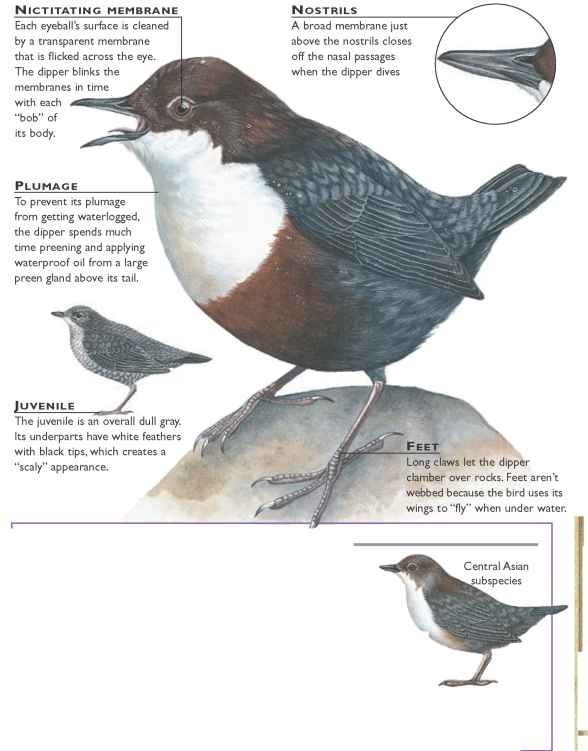
CREATURE COMPARISONS
Across Europe and Asia, the dipper has evolved into several distinct subspecies, each with different plumage. Northern European
subspecies (Cinclus cinclus cinclus) lacks the rich chestnut band below the white breast, that is a distinctive feature of the subspecies in Britain and Ireland (C. c. gularis). In central Asia, the subspecies C. c. leucogaster has almost all-white underparts. All dipper subspecies have a plump body and squarish tail, which is cocked upward.Their lifestyles, too, are similar, and all share the characteristic habit of bobbing, or dipping, up and down.
| VITAL | |
| STATISTICS | |
| Weight | 2-2.5 oz. |
| Length | 7-7.5″ |
| Wingspan | 10″ |
| Sexual 1 Maturity | 1 year |
| Breeding;.: Season | February ‘ -June |
| Number l of Eggs | 1-8, usually 4-5 |
| Incubation . Period | 12-18 days, usually 16 days |
| Fledging Period | 22 days |
| Typical Diet | Large aquatic invertebrates (mainly caddis fly larvae); some fish, snails, worms, leeches and crustaceans |
| Lifespan | 5 years |
RELATED SPECIES
• The dipper is in the [ family Cinclidae, which ‘ has four other species. j.Three species occur in ‘ the Americas: the whiter capped dipper (South 1 < America), American . dipper (North and . Central America) and rufous-throated dipper . (Argentina). The brown dipper is found in Asia. Dippers are closely i related to thrushes I. in the family Turdidae, I which has 310 members.
